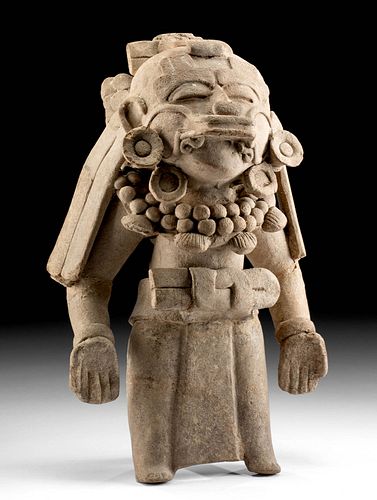Unusual Veracruz Pottery Standing Figure Whistle
Lot 210
About Seller
Artemis Fine Arts
686 S Taylor Ave, Ste 106
Louisville, CO 80027
United States
Selling antiquities, ancient and ethnographic art online since 1993, Artemis Gallery specializes in Classical Antiquities (Egyptian, Greek, Roman, Near Eastern), Asian, Pre-Columbian, African / Tribal / Oceanographic art. Our extensive inventory includes pottery, stone, metal, wood, glass and textil...Read more
Categories
Estimate:
$2,400 - $3,600
Absentee vs Live bid
Two ways to bid:
- Leave a max absentee bid and the platform will bid on your behalf up to your maximum bid during the live auction.
- Bid live during the auction and your bids will be submitted real-time to the auctioneer.
Bid Increments
| Price | Bid Increment |
|---|---|
| $0 | $25 |
| $300 | $50 |
| $1,000 | $100 |
| $2,000 | $250 |
| $5,000 | $500 |
| $10,000 | $1,000 |
| $20,000 | $2,500 |
| $50,000 | $5,000 |
| $100,000 | $10,000 |
| $200,000 | $20,000 |
About Auction
By Artemis Fine Arts
Mar 24, 2022
Set Reminder
2022-03-24 10:00:00
2022-03-24 10:00:00
America/New_York
Bidsquare
Bidsquare : Exceptional Antiquities Ethnographic Fine Art
https://www.bidsquare.com/auctions/artemis-gallery/exceptional-antiquities-ethnographic-fine-art-9057
Museum-worthy examples of classical antiquities (Egyptian, Greek, Roman, Near Eastern), Viking, Far East / Asian, Pre-Columbian, African / Tribal, Oceanic, Native American, Spanish Colonial, Fossils, Ancient Jewelry, Fine / Visual Arts, so much more! Artemis Fine Arts info@artemisfinearts.com
Museum-worthy examples of classical antiquities (Egyptian, Greek, Roman, Near Eastern), Viking, Far East / Asian, Pre-Columbian, African / Tribal, Oceanic, Native American, Spanish Colonial, Fossils, Ancient Jewelry, Fine / Visual Arts, so much more! Artemis Fine Arts info@artemisfinearts.com
- Lot Description
Pre-Columbian, Mexico, Veracruz culture, also known as Totonac (Totonaca), Remojadas, ca. 300 to 600 CE. A fascinating figure of a woman, probably a shaman but possibly a deity, who wears a huge, stylized mask or headdress, massive earrings, and a multi-stranded necklace of seeds and shells. A floor-length skirt is secured to her waist via a broad belt with a large knot at the front. The same knot form repeats on the top and back of the headdress. Two long straps hang down from either side of the top knot, reaching to the slightly bent elbows. The hands are facing outward, the palms spread, while the legs are straight and slightly spread. Fascinatingly, on the face, below a heavy nose ornament, is a projecting mask that gives the impression of being the snout and upper jaw of a jaguar. A whistle opening projects from the back of the figure, allowing it to be played. Size: 7.3" W x 11.7" H (18.5 cm x 29.7 cm)
The sophisticated skills used by the artist to construct this piece demonstrate how advanced ceramic technology was in this culture. The arms, head, and legs, all hollow, were made separately and fitted onto the torso, with the joints smoothed over to disguise them. The ornament was also constructed separately, then pressed onto the surface of the body. The piece was fired all together after the clay had dried for a brief period. Imagine the workshop where this item was made - full of disembodied limbs and heads in the process of being sculpted into shape. Who did this figure represent? Excavations near the modern Mexican town of Remojadas have revealed two types of impressive, detailed pottery figures from the Veracruz period: the Sonrientes, the joyous "smiling faces," and figures like this one, more serious, mostly adult figures, with elaborate costumes, themes, and sometimes props that all seem to point towards religious or political ceremonies. These figures are often found with the bodies smashed into pieces and the heads largely intact - they were ritually destroyed as burial offerings. Their clothing suggests that they depict people of import in society, maybe priests or nobility.
Cf. North Carolina Museum of Art, "Standing Female Deity or Deity Impersonator."
Provenance: private Hidden Valley Lake, California, USA collection, purchased on April 25, 2019; ex-Artemis Gallery; ex-John Rich collection, California, USA
All items legal to buy/sell under U.S. Statute covering cultural patrimony Code 2600, CHAPTER 14, and are guaranteed to be as described or your money back.
A Certificate of Authenticity will accompany all winning bids.
PLEASE NOTE: Due to recent increases of shipments being seized by Australian & German customs (even for items with pre-UNESCO provenance), we will no longer ship most antiquities and ancient Chinese art to Australia & Germany. For categories of items that are acceptable to ship to Australia or Germany, please contact us directly or work with your local customs brokerage firm.
Display stands not described as included/custom in the item description are for photography purposes only and will not be included with the item upon shipping.
#170481No longer functions as a whistle. Repaired from multiple pieces, notably on the arms and lower part of the skirt. Repairs are well done and difficult to see with restoration over break lines. Tiny chips and nicks, mostly around the head, are present and commensurate with age. Otherwise, excellent with nice deposits on surface and beautifully preserved detail of ornament.Condition
- Shipping Info
-
All shipping is handled in-house for your convenience. Your invoice from Artemis Gallery will include shipping calculation instructions. If in doubt, please inquire BEFORE bidding for estimated shipping costs for individual items.
-
- Buyer's Premium



 EUR
EUR CAD
CAD AUD
AUD GBP
GBP MXN
MXN HKD
HKD CNY
CNY MYR
MYR SEK
SEK SGD
SGD CHF
CHF THB
THB














